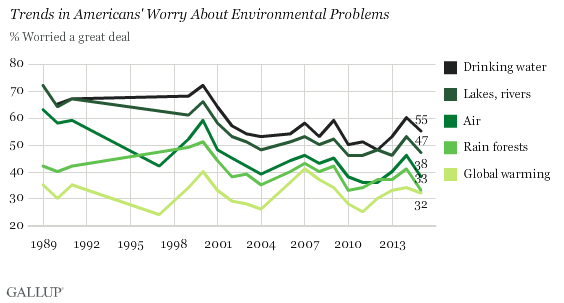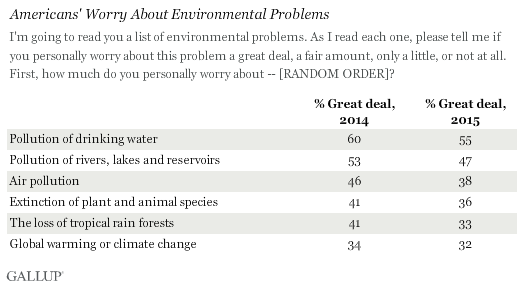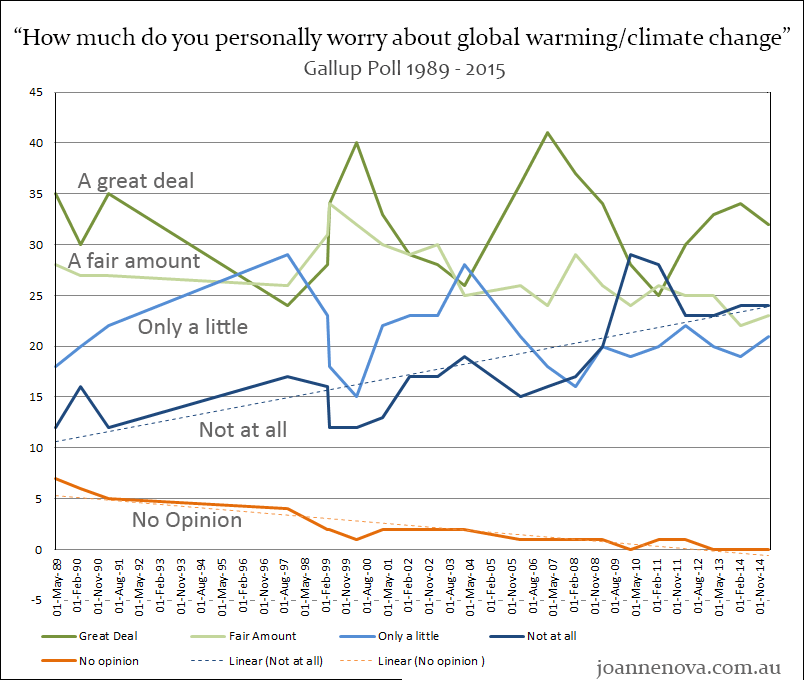GWPF | 26 March 2015
US Concern About Global Warming Drops To 1980s Levels
Less than a third of Americans are now concerned about global warming and climate change: 32 percent fret about those environmental factors says the annual Gallup Environmental survey, released Wednesday. Naturally, there’s a partisan divide: 13 percent of Republicans are concerned about global warming and climate problems, compared to 52 percent of Democrats. –Jennifer Harper, The Washington Times, 25 March 2015

Americans’ concern about several major environmental threats has eased after increasing last year. As in the past, Americans express the greatest worry about pollution of drinking water, and the least about global warming or climate change. Importantly, even as global warming has received greater attention as an environmental problem from politicians and the media in recent years, Americans’ worry about it is no higher now than when Gallup first asked about it in 1989. —Gallup, 25 March 2015
1) Gallup: Less Than A Third Of Americans Still Worry About Global Warming – The Washington Times, 25 March 2015
2) US Concern About Global Warming Drops To 1980s Levels – Gallup, 25 March 2015
3) One Quarter Of Americans Are Now Hard Core Climate Sceptics – Jo Nova, 26 March 2015
4) Sustainability: Higher Education’s New Fundamentalism – National Association of Scholars, 25 March 2015
5) Peter Foster: Climate Change As A Moral Issue – House of Lords, 24 March 2015
The new Gallup Poll is out. Most commentators are focused on the worried “a great deal” category, which is back to 1989 levels, but that’s largely noise. The important trend is at the other end of the spectrum, and seems to be missed. The only category with steady growth are the hard core skeptics, people who are worried “not at all”. That’s doubled from 12 to 24%; the trend is up. This is an unequivocal category. One quarter of the population are solidly, completely skeptical. —Jo Nova, 26 March 2015
The public’s obsession with climate change, a common feature during much of the 1980s and 1990s, has been waning rapidly. The reason for growing climate fatigue is not so much a PR failure. After all, hundreds of millions are being spent each year around the world by thousands of NGOs, green energy lobbies and green government ministers. It is rather that reality no longer corresponds with alarmist predictions that were issued just a few years ago. The novelty of global warming and the habitual alarm have lost their original shock value. Most people have begun to take climate scares with a sizeable pinch of salt. — Benny Peiser, PR Week, 10 September 2014
As United Nations delegates gather this week to negotiate new Sustainable Development Goals, the National Association of Scholars released the first major critical report detailing how the campus sustainability movement harms higher education. Sustainability: Higher Education’s New Fundamentalism shows that the sustainability movement distorts college curricula and cuts off free inquiry on important questions. The study shows how the sustainability movement has shut down reasoned debate on campuses by foreclosing open inquiry about climate change. —National Association of Scholars, 25 March 2015
I believe that climate moralists are impervious to the adverse impact of their policies because their morality is closely interwoven with misunderstanding of economics, distaste for capitalism, lack of interest in history and the overwhelming desire of their psychic elephants to dictate how other people should live. The climate issue has to be seen as the latest chapter in the two century long battle to use the alleged moral shortcomings of capitalism to justify political power. –Peter Foster, House of Lords, 24 March 2015
1) Gallup: Less Than A Third Of Americans Still Worry About Global Warming
The Washington Times, 25 March 2015
Jennifer Harper
Less than a third of Americans are now concerned about global warming and climate change: 32 percent fret about those environmental factors says the annual Gallup Environmental survey, released Wednesday. Naturally, there’s a partisan divide: 13 percent of Republicans are concerned about global warming and climate problems, compared to 52 percent of Democrats.
The majority of Americans worry about only one environmental issue, however. Fifty five percent are concerned about the pollution of drinking water. Next in line: 47 percent fret over lake and river pollution, air pollution (36 percent) and the loss of tropical rain forests (33 percent).
In general, Americans are more positive about the environment these days notes Gallup analyst Jeffrey Jones, with negative sentiments now at the “low end” of what the polling group has measured in the last 25 years.
“The nature of the environmental agenda may indirectly be influencing Americans’ concern. The primary focus of the environmental movement has shifted toward long-term threats like global warming – issues about which Americans tend to worry less than about more immediate threats like pollution,” writes Mr. Jones.
“Importantly, even as global warming has received greater attention as an environmental problem from politicians and the media in recent years, Americans’ worry about it is no higher now than when Gallup first asked about it in 1989.”
2) US Concern About Global Warming Drops To 1980s Levels
Gallup, 25 March 2015
PRINCETON, N.J. — Americans’ concern about several major environmental threats has eased after increasing last year. As in the past, Americans express the greatest worry about pollution of drinking water, and the least about global warming or climate change.

The results are based on Gallup’s annual Environment survey, conducted March 5-8. Gallup trends on many of these items stretch back more than two decades. Last year’s increased worry has proved temporary, with the current level of worry on each of the problems back to about where it was in 2013.
Despite ups and downs from year to year in the percentage worried about the various issues, the rank order of the environmental problems has remained fairly consistent over the decades. Americans express greater concern over more proximate threats — including pollution of drinking water, as well as pollution of rivers, lakes and reservoirs, and air pollution — than they do about longer-term threats such as global warming, the loss of rain forests, and plant and animal extinction.
The amount Americans worry about the various threats tends to rise and recede in unison, with concern higher in the late 1980s and early 1990s during the revival of environmentalism, and in the late 1990s and early 2000s amid the economic boom. Since then, Americans’ worry has fallen, with concern dipping to record lows on most issues in 2010 or 2011. The current level of worry on each issue remains at or near those record lows.

Consistent with the decline in worry about specific environmental problems, Americans have become more positive about the quality of the environment in recent years. If Americans perceive the environment to be in relatively good shape, it follows they would be less concerned about potential environmental threats to Americans. The more positive views about the environment could be the result of federal, state and local government’s as well as individuals’ actions to minimize potential environmental threats to U.S. citizens.
The health of the economy may also be a factor in reduced worry about environmental problems. Americans tend to give environmental concerns higher priority when the economy is healthy than when it is ailing, and in recent decades the U.S. economy was arguably its strongest in late 1999 and early 2000.
Also, the nature of the environmental agenda may indirectly be influencing Americans’ concern. The primary focus of the environmental movement has shifted toward long-term threats like global warming — issues about which Americans tend to worry less than about more immediate threats like pollution. Importantly, even as global warming has received greater attention as an environmental problem from politicians and the media in recent years, Americans’ worry about it is no higher now than when Gallup first asked about it in 1989.
A final factor is the politicization of environmental issues. This is exemplified by the sharp political polarization in views of global warming. And although concern about environmental issues is lower among both Republicans and Democrats since 2000, it is down more among Republicans. Across the six issues measured in 2000 and 2015, the percentage of Republicans and Republican-leaning independents who worry “a great deal” is down an average of 20 percentage points, compared with an average 10-point decline for Democrats and Democratic leaners.
Democrats worry more than Republicans about all of the issues. Notably, Democrats are more worried about global warming now than they were in 2000, perhaps reflecting the shift in the focus of the environmental agenda toward this issue.
3) One Quarter Of Americans Are Now Hard Core Climate Sceptics
Jo Nova, 26 March 2015
The new Gallup Poll is out. Most commentators are focused on the worried “a great deal” category, which is back to 1989 levels, but that’s largely noise. The important trend is at the other end of the spectrum, and seems to be missed. The only category with steady growth are the hard core skeptics, people who are worried “not at all”. That’s doubled from 12 to 24%; the trend is up. This is an unequivocal category. One quarter of the population are solidly, completely skeptical.
Given the 4% errors, there are only two clear trends in this table below. Firstly, those who had no opinion have now got one, and it’s skeptical. Secondly, the number of the most implacable skeptics has doubled. After 20 years of propaganda the section of the population that is not buying the scare is steadily increasing. The size of the groups with variable levels of worry flicks up and down as people switch. But the numbers of those who worry “not at all” are steadily rising, and therein lies the death of the scare. It’s a one way ticket from being uninformed and worried to the “only a little/not at all” category.
The “enviro-scare” campaign has over-played its hand.
Here are the trends over the last 25 years of propaganda-filled repetition. No major western party or institution or news outlet is an outspoken declared skeptic. Tony Abbott runs one of the most skeptical governments in the west, but even he is promising billions to deal with climate change. The UN, the World Bank, the EU, most science associations and every single government agency says “climate change is real”. But despite that monotony, a quarter of the population are absolute skeptics and it’s growing. That growth comes from word of mouth, books, radio, and blogs. Q14D Gallup 2015.
The base of the “greatly worried” group bottoms out in “bad years” (for them) at a quarter of the population too. This is probably the limit of the current implacable believers, the unreachable core. It will be interesting to how much further that number may fall. Twenty years from now it may have shrunk to the 8% – 10% type group who vote Green regularly.
But right now, the skeptical must be focused on sharing messages with the middling fear groups. Half of the population lie between the die-hard skeptics and the die-hard believers, and they can be reached.
4) Sustainability: Higher Education’s New Fundamentalism
National Association of Scholars, 25 March 2015
NEW YORK, MARCH 25, 2015— As United Nations delegates gather this week to negotiate new Sustainable Development Goals, the National Association of Scholars released the first major critical report detailing how the campus sustainability movement harms higher education.

The Greening of the Curriculum
Students can now earn credentials in sustainability in 1,438 distinct college programs, ranging from certificates to doctoral degrees. But sustainability is also a theme that has spread across the whole college curriculum, including seemingly unlikely subjects such as English composition, mathematics, and psychology.
“Harnessing higher education and the liberal arts into the service of sustainability seriously undermines their purpose,” said Peter Wood, co-author of the report and president of the National Association of Scholars. “It treats other disciplines as mere grist for the sustainability mill.”
What Sustainability Costs
The report examines how much colleges and universities spend to achieve their sustainability goals. Using Middlebury College in Vermont as a case study, the authors find that the costs far outrun the purported savings. Middlebury spends close to $5 million annually on sustainability efforts. The report estimates that American colleges and universities overall spend over $3 billion per year on sustainability-related programs and initiatives.
“Colleges and universities fail any test of transparency on the costs of sustainability,” said Wood. “Colleges routinely boast that their sustainability ‘investments’ save money, but they make these claims behind an opaque wall.”
The Nudge-Culture of Sustainability
Sustainability: Higher Education’s New Fundamentalism shows that many colleges and universities attempt to manipulate students into complying with sustainability goals. Students are not only bombarded with promotional material and pressured by peers, they are also manipulated with sophisticated programs designed by psychologists to “nudge” them into new patterns of behavior.
“The campus sustainability commitment represents a significant shift in higher education, away from giving students access to rational and moral knowledge that prepares them for wise, conscious choices, and towards training operations that elicit automatic responses,” stated Rachelle Peterson, co-author of the report.
5) Peter Foster: Climate Change As A Moral Issue
Global Warming Policy Forum, 24 March 2015
Talk in the House of Lords, Committee Room 3, London 24 March 2015
Thomas Kuhn, in his classic book on the structure of scientific revolutions, points out how difficult scientific paradigms are to shift. He suggests they become even more so when there is a moral element involved. I will suggest that projected catastrophic man-made climate change is less a scientific theory with a moral element than a moral crusade that has recruited a scientific theory.
The great global warming fandango is – at root — the latest example of politically expedient demonization of the capitalist system.
First let me provide some background on how I came to this issue, and pay tribute to a very important academic advisor to the GWPF: David Henderson.
Two of David’s works — his Reith lectures, Innocence and Design, and his book, The Role of Business in the Modern World – were both inspirational for my own recent book: Why We Bite the Invisible Hand. […]
Two recent Global Warming Policy Foundation papers have touched on climate and morality, one by Peter Lee and one by Andrew Montford.
Professor Lee differentiates between those who regard the environment in an Eden-like sense, as a pristine system which is corrupted by man, and those who believe that Nature is here for man’s use.
(The elevation of pristine Nature is in fact often synonymous with hatred of man, which goes with the desire to control him, and his wicked ways.
That hatred is particularly strong towards the parody of capitalist man – homo economicus – as a short-sighted, rational maximizer with no concern for his environment or other people beyond their commercial use to him).
Professor Lee acknowledges that pragmatic approaches to poverty, and adaptationists approaches to climate “will not satisfy those… who have unstated ideological ambitions such as anti-capitalism or wealth redistribution enmeshed with their ideas for the mitigation of climate change.”
I would suggest that those ideological ambitions may not just be unstated. Those in their grip may be either unaware of them, or at least reject the notion that they are in any way ideological.
It is a peculiarity of the liberal left since Marx to believe that ideology is for others. They, by contrast, are motivated by nothing but “inconvenient truth.”
When Professor Lee concludes with “a plea for balance, transparency, honesty and achievability” in climate policy, I suspect that he realizes that his plea is falling on deaf ears.
But then deaf ears are in fact an aspect of evolved moral psychology. I’ll get back to that shortly.
Andrew Montford’s latest paper notes how the “sanctimonious slogans” of “intergenerational justice” don’t seem to fit with the realities of inefficient, bird-mangling windmills, and biofuel policies that starve the poor.
Andrew rightly suggests that “A public debate on the damage being done by climate change policy is long overdue.”
The problem is that the Church of Climate has no interest in such a debate.
Indeed, from its perspective, even to listen to opponents is to dignify wicked people. […]
I believe that climate moralists are impervious to the adverse impact of their policies because their morality is closely interwoven with misunderstanding of economics, distaste for capitalism, lack of interest in history and the overwhelming desire of their psychic elephants to dictate how other people should live.
The climate issue has to be seen as the latest chapter in the two century long battle to use the alleged moral shortcomings of capitalism to justify political power.



